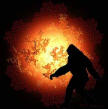Yeti from Russia's Vyatka
Moscow explorers discovered a wigwam of a creature unknown to science in the snow-covered forest
Members of the Kosmopoisk association have returned from an expedition to Russia's Kirov Region where they searched for a bigfoot that allegedly lived in that region. Kosmopoisk leader Vadim Chernobrov says the expedition has discovered a den occupied by a mysterious giant and an underground passage dug obviously not by a human.
Ivan Konovalov has been working as a forest warden for 30 years in the Kirov Region. At first, the man did not plan to stay in that region for long, however he had an important meeting in November 1985 and changed his mind. Ivan Konovalov tells about that meeting: "It was snowing on the day when I was walking along the fir wood and suddenly heard snap of twigs. I turned around and saw an awesome creature covered with dark hair that was much taller than me. It smelt strongly. The beast leant against a pine tree and started bending it down to the ground. The tree was rather thick, but it cracked under the creature's burden. Then the creature started breaking the tree against the knee. Its hands were as thick and long as its legs. Quite of a sudden, the creature felt something and turned its "face" to me. I saw two black eyes and the impression at the bottom of the eyes deeply impressed me. I still remember the look of the eyes. Then the creature flung the tree and quickly left. But I stood thunderstruck and could not move a finger."
After that awesome meeting the forest warden was anticipating another meeting with the bigfoot. However, the man did not doubt that it was a snowman. Ivan Konovalov thinks the creature unknown to science has some mysterious capabilities resembling hypnosis.
It was only twice that he managed to come across the creature face to face. Another time Ivan Konovalov met with a she-yeti and a baby. They noticed the forest warden and ran deep into the forest emitting sounds resembling dog's barking.
Hunter Vasily Kapustin tells that he has seen numerous footprints of a snowman, but came across the creature only once. A hairy creature attacked a young elk, shouldered it and directed toward the forest. When the yeti saw the hunter it was at first confused, then looked at the man with astonishment, emitted some indistinct sound and rushed into the deep forest. Vasily Kapustin felt as if he stood for 15 minutes and then went toward his village. But when he came home it turned out he had spent about four hours in the forest! He had a headache and felt as if he had a hangover. But the hunter was an abstainer. He made an effort to get back to the place where he came across the yeti and discovered the footprints of an enormous naked foot looking very much like a human foot, but wider and bigger in fact. The snow on the site was spotted with blood of the baby elk obviously. However, it was not clear how the creature managed to escape through the deep forest and broke no branches and left practically no traces.
Vadim Chernobrov, the leader of the expedition tells that hunters are as a rule not talkative men; but they enjoy respect of the local population. Locals do believe that some strange forest creatures exist in fact. Those who have ever come across such creatures are treated as people's heroes there.
The two hunters helped the expedition to search the place. Vadim Chernobrov tells that the group set up a tent camp in a big meadow. "I had many baits that were to help us catch a yeti. On the first night the group was really very tired and did not arrange the baits. The baits remained in my tent. The group put out the fire and appointed a man on duty for the night. When we woke up early in the morning we saw a torn side of my tent as if someone attempted to get inside of the tent. My rucksack stood half a meter away from the torn side of the tent. But the man on duty was on the top of a tall pine tree clutching at branches. The guy had a hatchet, and all branches were cut under his feet. It took us much effort to take him down from the tree. He was white from terror, his hands and legs were trembling and he could hardly speak. In two hours he started crying and said he wanted to go back home. His home was far from the tent camp, however the man was so terror-stricken that he would not stay there."
On the next nights, the group chose more experienced people to be on duty. But they did not see anything scary at all. Baits laid around the tent camp brought no success. However, when members of the expedition went deep into the forest in broad daylight they discovered strange things there: trees broken so neatly as if someone chopped firewood there and incisions on trees made either with teeth or with claws.
It was only once that the expedition was actually rewarded for the persistence: the group discovered a den made of stems of trees in the middle of a forest clearing. The den of five square meters did not resemble people or animal's habitation. Vadim Chernobrov together with some members of the group walked around the den and then decided to get inside.
The floor of the den was laid out with logs and rotten leaves, the walls were strong and did not let the cold wind pass through. There was nobody inside of the den. There was some construction covered with sticks in the middle of the "room". Under the sticks, there was a hole of about one meter in diameter leading deep under the ground. The hole was highly likely very deep as a stone thrown down emitted no sound at all. The expedition decided it was an underground passage. However, the group had no special equipment to come down the passage. They just charted the site to get back to it later.
The leader of the expedition says it is now important to gather many experts, biologists, zoologists and doctors to organize another expedition to the mysterious site in the Kirov Region.
Alexey Rozanov, a correspondent member of the Russian Academy of Sciences Paleontology Institute says that yeti is one of the most mysterious puzzles of present-day science. Opinions still differ whether yeti exists or not. Some people believe there is no documented evidence proving existence of yeti; all photos and videos allegedly showing yeti are falsifications. Others say that yetis are in fact baboons, huge monkeys, and Himalayan bears about two meters tall. There is an opinion that yeti is an offshoot of the primates developing parallel to human beings. At the time when human brain and intellect developed, yeti acquired some extrasensory capabilities. Some researchers believe that people's hairy neighbors can not only hypnotize, but also levitate, become invisible or cure any diseases with a glance. There are even more fantastic hypotheses saying that yetis are wood-goblins, demons or some beings from the parallel world. Unfortunately, there is not single evidence proving any of the fantastic suggestions.
Legends about yeti go back to the antiquity; it was mentioned for the first time about 4 thousand years ago, crypt-zoologist, doctor of biological science Alexander Bayanov tells. More information about yeti appears every year. Japan mountaineers left for the Himalayas in August 2002 to search for yeti; they got back from the expedition absolutely confident that yeti actually existed. The mountaineers brought about ten pictures of yeti footprints taken on the slopes of the Dhaulakhari mountain and told they had seen an apelike creature quickly running about the mountain slopes. There is evidence provided by an American mountain-skier who came across two hairy creatures when he descended from Everest. He says the creatures were neither animals nor humans. The meeting ended like any other story connected with yeti: the creatures suddenly disappeared.
In two months, it was reported from Pakistan that a hairy creature near the settlement of Haripura attacked a 20-year-old native. The creature seized the guy's shoulder and scratched him, but when the native cried, the creature got scared and ran away. Doctors examined the guy's wounds, but could not say what the creature actually was.
A hairy very tall creature was also once seen in Russia near the cities of St.Petersburg and Tomsk. A mummified paw of some ancient animal belonging to none of the known to science species was discovered in Russia's Altai Mountains. Vice-president of the Russian Association of Vet Anatomists Yury Malafeyev took an X-ray photograph of the paw and made a conclusion that it looked very much like a human hand, but covered with red fur and of a bigger size.
Natalia Leskova
Subscribe to Pravda.Ru Telegram channel, Facebook, RSS!





